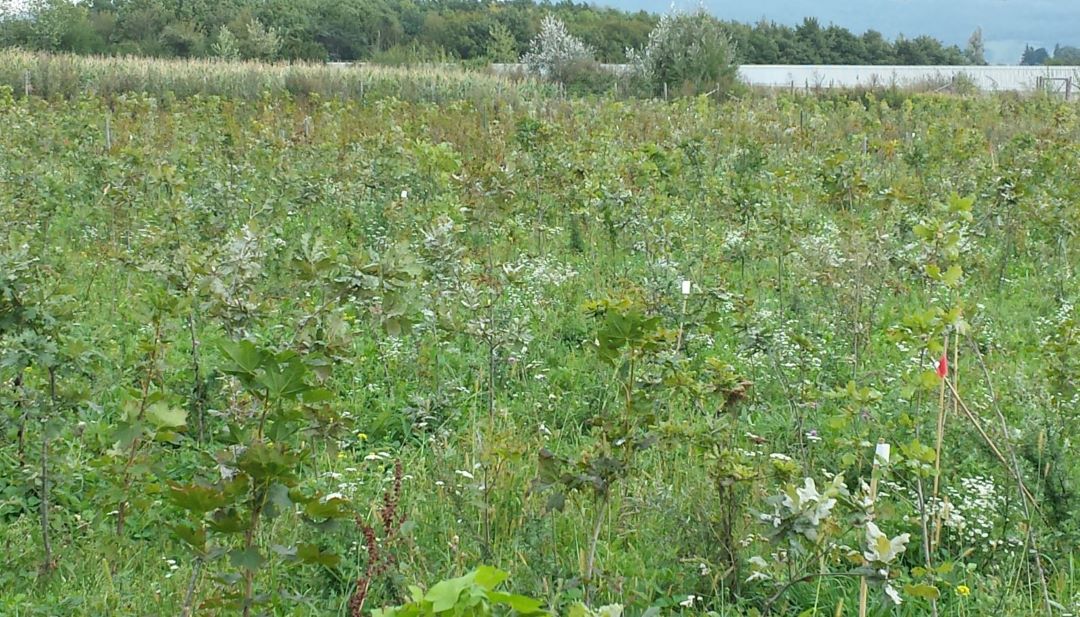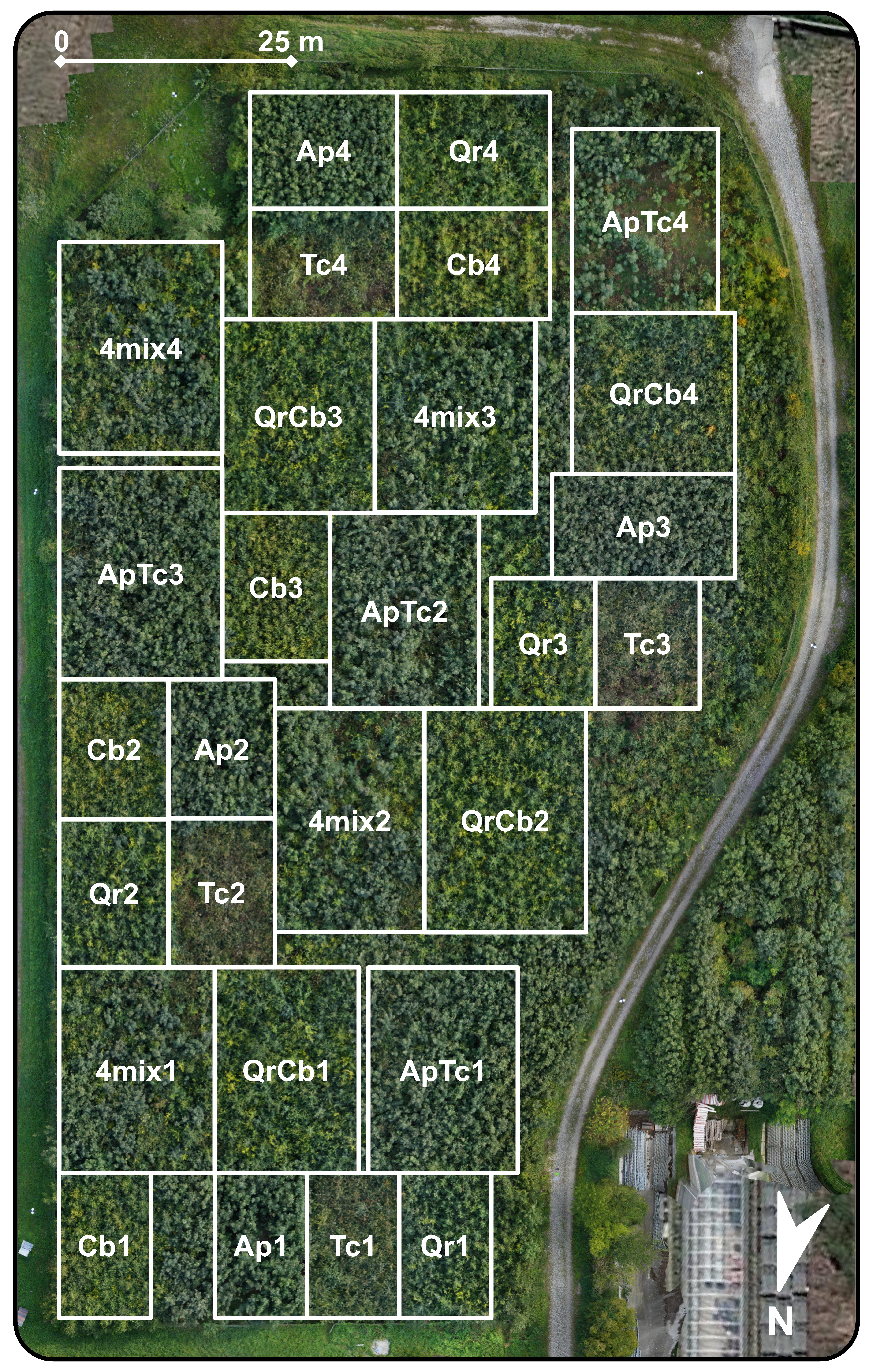B-Tree (Austria)
B-Tree, planted in April 2013, represents the typical mixtures of a warm lowland forests of Austria. The effects of tree diversity on growth, water relations, rhizosphere diversity and C sequestration will be investigated.

Design
The full factorial design consists of monoculture plots and plots of 2 or 4 species. The planted 2-species mixtures will allow the comparison of blocks dominated by tree species associated with ectomycorrhizal fungi (Carpinus and Quercus) or arbuscular mycorrhizal fungi (Tilia and Acer). Each monoculture or species mixture is replicated 4 times. The trees are planted in a hexagonal design with 1 m distance between each tree, which will allow thinning after canopy closure.

Site characteristics
| B-Tree (Tulln) | |
|---|---|
| Country | Austria |
| Biome | temperate |
| Latitude | 48.33 |
| Longitude | 16.06 |
| Soil type | moist chernozem |
| Former land use | grassland with trees |
| Altitude | 200 m |
| Design | stem-wise randomisation |
| Plot shape | rectangular |
| Plot size (m^2) | 170-300 m² |
| Plant distance (m) | 1 |
| Number of trees planted | 11 000 |
| Planting date | April 2013 |
| Diversity variables | species richness mycorrhizal type |
| Diversity gradient | 1, 2, 4 sp. AM or EM fungi |
| Size species pool | 4 |
| Species pool | Acer platanoides Carpinus betulus Quercus robur Tilia cordata |
| Contact person | Douglas Godbold |
| douglas.godbold@boku.ac.at |
Research
Studies will focus on the effects of tree diversity on tree growth, water relations, rhizosphere diversity and C sequestration.
Extra information
For more information on the B-Tree experiment, send an e-mail to the contact persons or explore the publications that utilized data from this experiment.
Research papers
- Blondeel H, Guillemot J, Martin‐StPaul N, Druel A, Bilodeau‐Gauthier S, Bauhus J, … Baeten L 2024 Tree diversity reduces variability in sapling survival under drought. Journal of Ecology 112(5): 1164-1180 - https://doi.org/10.1111/1365-2745.14294
- Luo S, Schmid B, Hector A, Scherer‐Lorenzen M, Verheyen K, Barsoum N, Bauhus J, Beyer F, Bruelheide H, Ferlian O, Godbold D, Hall JS, Hajek P, Huang Y, Hölscher D, Kreft H, Liu X, Messier C, Nock C, Paquette A, Parker JD, Parker WC, Paterno GB, Reich PB, Rewald B, Sandén H, Sinacore K, Stefanski A, Willams L, Eisenhauer N 2024 Mycorrhizal associations modify tree diversity− productivity relationships across experimental tree plantations. New Phytologist 243:1205-1219 - doi: 10.1111/nph.19889
- Steinparzer M, Gillerot L, Rewald B, Godbold DL, Haluza D, Guo Q, Vospernik S 2024 Forest temperature buffering in pure and mixed stands: A high-resolution temporal analysis with generalized additive models. SSRN. http://dx.doi.org/10.2139/ssrn.4780880
- Werner R, Gasser LT, Steinparzer M, Mayer M, Ahmed IU, Sandén H, Godbold DL, Rewald B 2024 Early overyielding in a mixed deciduous forest is driven by both above- and below-ground species-specific acclimatization. Annals of Botany, mcae150. https://doi.org/10.1093/aob/mcae150
- Zheng L, Barry KE, Guerrero-Ramírez NR, Craven D, Reich PB, Verheyen K, … Hautier Y 2024 Effects of plant diversity on productivity strengthen over time due to trait-dependent shifts in species overyielding. Nature communications 15(1): 2078 - https://doi.org/10.1038/s41467-024-46355-z
- Depauw L, De Lombaerde E, Dhiedt E, Blondeel H, Abdala-Roberts L, Auge H, Barsoum N, Bauhus J, Chu C, Damtew A, Eisenhauer N, V. Fagundes M, Ganade G, Gendreau-Berthiaume B, Godbold D, Gravel D, Guillemot J, Hajek P, Hector A, Hérault B, Jactel H, Koricheva J, Kreft H, Liu X, Mereu S, Messier C, Muys B, Nock CA, Paquette A, Parker JD, Parker WC, Paterno, GB, Perring MP, Ponette Q, Potvin C, Reich PB, Rewald B, Scherer-Lorenzen M, Schnabel F, Sousa-Silva R, Weih M, Clara Zemp D, Verheyen K, Baeten L 2024 Enhancing Tree Performance Through Species Mixing: Review of a Quarter-Century of TreeDivNet Experiments Reveals Research Gaps and Practical Insights. Current Forestry Reports - https://doi.org/10.1007/s40725-023-00208-y
- FAO 2023 Towards more resilient and diverse planted forests. Unasylva (254)74: 2031/1. Rome. https://doi. org/10.4060/cc8584en
- Steinparzer M, Haluza D, Godbold DL 2022 Integrating tree species identity and diversity in particulate matter adsorption. Forests, 13(3), 481. https://doi.org/10.3390/f13030481
- Messier C, Bauhus J, Sousa-Silva R, Auge H, Baeten L, Barsoum N, Bruelheide H, Caldwell B, Cavender-Bares J, Dhiedt E, Eisenhauer N, Ganade G, Gravel D, Guillemot J, Hall JS, Hector A, Hérault B, Jactel H, Koricheva J, Kreft H, Mereu S, Muys B, Nock CA, Paquette A, Parker JD, Perring MP, Ponette Q, Potvin C, Reich PB, Scherer-Lorenzen M, Schnabel F, Verheyen K, Weih M, Wollni M, Zemp DC 2021 For the sake of resilience and multifunctionality, let’s diversify planted forests! Conservation Letters e12829 - https://doi.org/10.1111/conl.12829